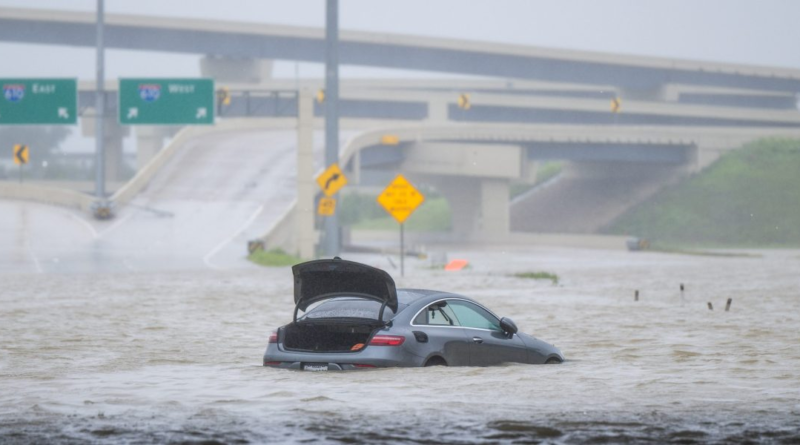FEMA is denying requests for aid as relief fund runs dry amid record number of costly disasters
A once in 200-years storm dumped 11 inches of rain over four hours on the central Massachusetts town of Leominster in September, washing away culverts, creating a sinkhole that swallowed cars at a dealership and flooding the city council chambers with sewage.
Damages to public infrastructure in Leominster exceeded $24 million, but the federal government denied a request for reimbursement to fix everything from dams to sanitation mains, and rejected Governor Maura Healey’s bid for a major disaster declaration for impacted counties in the center of her state. And last month, Healey said the US Federal Emergency Management Agency turned down her appeal.
“The perception of most is FEMA is there when you get into large scale events — they are going to help you,” said Leominster Mayor Dean Mazzarella, who is now weighing how to pay for both a new elementary school that was planned before storms hit and the damage they caused. “Practice self reliance. If you are waiting for the federal government to help, lower those expectations.”
Leominster joins a growing roster of municipalities that FEMA has denied aid to as it copes with natural disasters that are increasing in frequency, strength and costs. Just this month, Hurricane Beryl became the earliest-forming Category 5 Atlantic hurricane on record. The agency is stretched thin with a record number of billion-dollar catastrophes and a mission that’s expanded to cover Covid-19 and the migrant care crisis. And it’s captive to a hyper-partisan federal budget process that risks letting its primary relief fund run dry for a second year in row.
President Joe Biden declared 71 major disasters last year, the most since the start of the pandemic. At the same time, FEMA also denied 14 requests, the most since 2016. FEMA said the damage in Leominster was “not of such severity and magnitude as to warrant the designation of Public Assistance.”
Already this year, the US has been hit by 15 weather and climate disasters each costing at least $1 billion, according to the National Oceanic and Atmospheric Administration. There were a record 28 such billion-dollar storms last year.
The number of disasters FEMA actively managed during the height of the last hurricane season more than doubled to 71 from 2016, according to the Government Accountability Office. After 2017, its daily deployment jumped to about 7,100 workers from about 3,300 before then, the GAO said. And FEMA has been about 6,000 workers short of staffing goals, according to most recent estimates.
FEMA’s Disaster Relief Fund could be depleted by mid August without additional money from Congress, Homeland Security Secretary Alejandro Mayorkas told the Associated Press last month. The fund faces a more than $6 billion deficit without supplemental appropriations, according to its most recent monthly report.
Last year, the Disaster Relief Fund was forced to halt payments for about a month – the first time it had to do so since 2017 — for thousands of projects not considered immediate as it was running out of money. For example, funding was delayed for projects related to past hurricanes and wildfires.
“If FEMA funding doesn’t grow at the same rate of disasters, something is going to give,” said Sarah Sullivant, a managing director at S&P Global Ratings. “These disasters are getting more costly. It will require more funding for FEMA. If that funding is not forthcoming, we are talking about long-term state and local governments being on the hook for more.”
FEMA said it’s working with the administration and Congress to ensure sufficient funding is available. If that doesn’t come through, the agency will ensure resources are available to support ongoing lifesaving and life sustaining activities.
“Most people may not realize FEMA is managing 500 open disaster declarations going back to sometimes 20 years to Hurricane Katrina,” Chris Currie, director of the homeland security and justice team for the GAO, said during a March Congressional hearing. “While FEMA is always going to prioritize response efforts and lifesaving efforts, the impact that this has is really on the long tail and recovery projects that FEMA manages.”
Although federal aid is often marshaled to help communities in the aftermath of major disasters and immediate live-saving aid isn’t in doubt, the surging financial toll is spurring more and more questions about whether FEMA can keep up.
“FEMA can’t be all things to all people,” Missouri Republican Congressman Sam Graves said during the hearing, adding that states should be shouldering a larger share of disaster aid.
In Massachusetts, the state stepped in to help pay for fixes to public facilities in Leominster after FEMA rejected its claim, though FEMA approved individual assistance to help residents who suffered flood damage. Governor Healey in June announced the state was giving $5 million in aid to local communities. Earlier this year, she also proposed a new state Disaster Relief and Resiliency Fund to prepare Massachusetts for quick response to natural disasters.
Traditionally natural disasters have had limited impacts on municipal budgets because FEMA has largely served as a backstop since the agency’s creation under President Jimmy Carter. But the rising number and costs of disasters have fueled concerns in a corner of Wall Street that lends money to local governments to build roads and schools and sewers and town halls.
Situations such as the one facing Leominster have come to be known as a “disaster gap,” said Tom Doe, founder of Municipal Market Analytics.
“A reliance on federal funding is expected to be inadequate in future years because of outsized demands on FEMA while the federal deficit continues to rise,” Doe said. “State and local governments will be forced to finance necessary projects to reduce the negative consequences from climate events.”



